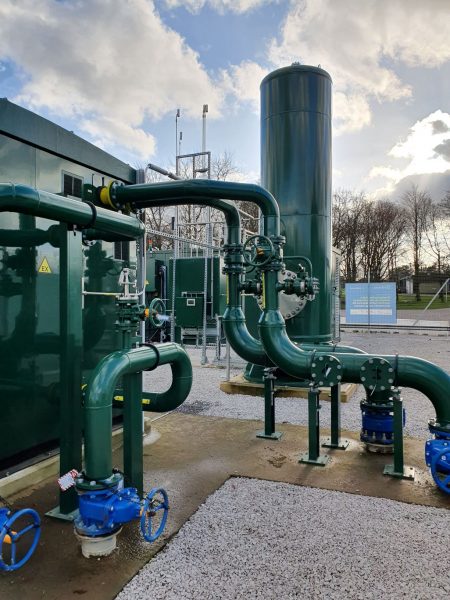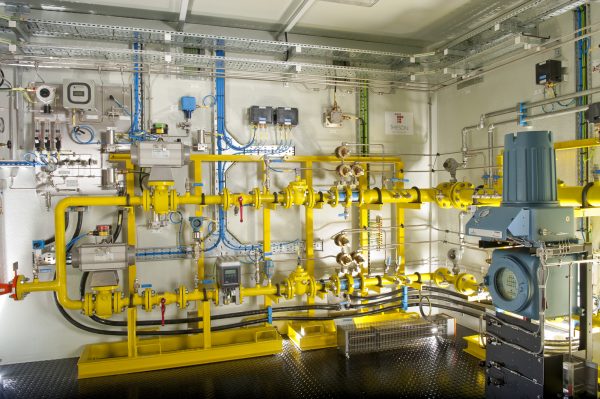The H-word: Hydrogen – the energy game-changer
May 19, 2021
by Neil Stuchbury, Thyson
Hydrogen: the energy game-changer
Hydrogen is already a game changer in the energy industry, it’s just not started to grab consumer headlines – yet. From leading UK gas networks piloting the mixing of hydrogen gas into the distribution systems; to the energy industry introducing categories to standardise its production as either green, blue or grey; to the trial run of hydrogen trucks by UK household names, and the dawn of a commercial, if not domestic, demand for hydrogen vehicles; hydrogen gas is set to be the energy game-changer of the 2020s.
This blog provides an overview of some of those different opportunities, as they stand in early 2021.
Airships and atom bombs?
The public often has strange and interesting collective memories about science and engineering – often when it appears to have gone wrong. The Hindenburg disaster in 1937 is still one story many automatically think of, when it comes to hydrogen. The hydrogen bomb played a significant and ominous role in the conclusion of the Second World War. It’s no wonder that for some, the thought of using hydrogen in our homes and on our roads, might cause some apprehension. Yet hydrogen is back as an energy resource, for domestic homes, for commercial vehicles and soon, as a household topic of conversation.
Like every element on the periodic table, hydrogen has its pros and cons. Hydrogen is more prevalent to leaking and more explosive than natural gas, for example. Yet it has other excellent properties, notably that it is hydrogen and not carbon and causes few environmental concerns. Over the past five years, slowly but surely, hydrogen has been a serious part of the UK energy agenda as an option for reducing carbon emissions from domestic and industrial combustion processes, primarily an alternative to natural gas “The Hydrocarbon”.

Hydrogen in the mix
Natural gas, including gas metering, has been a well-developed industry since the 1970s, both commercially and domestically. Although hydrogen as an energy source sounds new, it isn’t as new as you might think. Prior to North Sea gas exploration and production, the UK used town gas, which comprised 50% hydrogen with other components that weren’t so clean, so many UK homes have already been supplied by a hydrogen mix of gases, although not for a very long time.
The recent hydrogen projects at Keele University (HyDeploy) and Winlaton (HyDeploy 2), have seen partnerships between leading UK gas networks, university, engineering (Thyson), government and other commercial organisations, to conduct trials to understand how to blend hydrogen with natural gas, in order to be able to reduce the carbon footprint of the combustion processes fed with gas from network, mostly producing heat. Although existing domestic cookers and boilers installed are not able to combust 100% hydrogen safely or effectively, a low percentage mix of up to 20% hydrogen : 80% natural gas is proving safe and effective in lowering carbon emissions with existing infrastructure.
Already, leading global boiler manufacturers are developing hybrid and hydrogen-fuel commercial and domestic boilers, anticipating it won’t be long before this practice becomes an option, with the vision that hydrogen will be one of a number of green heat options, not only in the UK, but across the world, over time. There are also plans afoot to create hydrogen towns such as the SGN H100 project, where the sole fuel source is hydrogen; naturally, these early pioneering engineering test projects are laying down the ground rules and requirements for a hydrogen future that isn’t that far away.
Which colour hydrogen?
This step change is significant and suggests that hydrogen could be a large part of the answer to many of the energy questions we’re all facing. You can produce it easily through existing energy and other production processes, making it straightforward to access and deliver. Hydrogen has even been categorised into different colours, depending on how it’s produced, to give users and investors better insight as to its origins and carbon emission contribution. For example, hydrogen can be produced from electrolysers powered by wind turbines, especially valuable if curtailed. It can also be collected during the manufacture of fertilisers. Wind farm hydrogen production is classed as green hydrogen. Hydrogen produced from natural gas, where there are carbon emissions released to atmosphere, is called grey hydrogen, and there are other types of hydrogen as well such as blue, grey hydrogen but where the carbon emissions are captured and stored (CCUS). The very fact that hydrogen production is already being graded and classified, according to its credentials, demonstrates its viability and the depth of investment and confidence the industry already has now and for the future.

Green wind!
With enough space, and if the wind blew all the time, we could make green electricity and green hydrogen continuously, and there would be zero carbon footprint, except for during the construction and maintenance of the turbines and cables themselves. The beauty of green hydrogen is that you can have dual feeds into the grid, producing both electricity and hydrogen, all at the same time. Even the most casual observer of a wind farm, on or offshore, will have noticed that wind turbines don’t always turn. There can be a whole bank of turbines moving gracefully in the wind, and others next to them with the brakes on. There are a number of reasons for that, but usually it’s because the grid is at capacity,. We’ve all thought, when we see this, that it’s such a waste of potential energy. In fact, a study by LCP shows that wind was curtailed in Great Britain on 75% of days in 2020, with over 3.6 terawatt-hours of wind being turned off in total, mainly due to network constraints. This volume of wasted wind power is enough to have powered over a million homes for a whole year. If wind farms also have an electrolyser utilising curtailed powerto produce hydrogen, which unlike wind, can be stored underground for future use, then the potential for wind farms to become hybrid energy farms, is tremendous.
I like driving in my car…
No one can deny the profile and greater visible presence electric vehicles (EVs) have achieved over the past three years. With premium brands like Elon Musk’s Tesla and mainstream cars like Nissan’s Leaf, it’s clear the public appetite to reduce their carbon emissions is growing. The challenge with EVs is always going to be battery life. At their best, they’re realistically good for about 320 miles and to travel any further, you have to stop and recharge. Hydrogen vehicles, however, have no such limitations and are far more similar to a petrol or diesel-powered car in that they just need refilling at regular intervals, stopping only as long as it takes to fill the tank and pay.
It’s not too far away from a time when domestic users travelling shorter distances, around town or between towns, will opt for an EV that they can charge overnight at their own home or at the office during the day. For the heavier vehicles , such as haulage trucks, buses, vans and so on, hydrogen fuelled vehicles will afford them significantly higher range on one tank and minimal refill times with the likes of the Aberdeen bus service have been using for a few years. Already, just up the road from us in Aintree, Ulemco is developing and marketing fuel conversion kits for vehicles to switch from diesel to hydrogen, making in roads with fleets such as the London Ambulance service, commencing trials in Autumn 21. The pressure is on for logistics businesses of all shapes and sizes to demonstrate and prove their green credentials and reduce their carbon emissions; apart from anything else, low emission vehicles pay significantly lower or no road tax in the UK. This makes hydrogen trucks commercially attractive, and a great incentive to support commercial operators to reduce their carbon footprint.
Our future transport needs are not going to be solved by just one great idea. Rather, there’ll be – and in fact it’s already happening – a mixed fuel economy with EVs taking a lead at home and LNG, CNG followed by hydrogen taking the lead for moving goods across large distances.
The times, they are a-changin’
The energy landscape is changing swiftly. Only five years ago in the UK, the general consensus in government was that everything would go electric, “UK Electrification” hence very costly contracts signed to support construction of new nuclear energy plants. Yet now it’s much clearer that we’re going to need a mixed fuel economy, increasingly with fuel sources that have green credentials that the general public can both understand and consequently embrace.
With our North West colleagues Ulemco, for example, they’re also trialling vehicle conversions with the Royal Mail and Thyson are proposing production of hydrogen from methanol for use in UK ports (Cold Ironing). Hydrogen production from methanol is considered grey but you can also produce hydrogen from bio-methanol, potentially offering negative emissions. Green H2 is the utopia but all these forms of hydrogen have their place on this journey we’re on; like every other current energy resource, there’s always going to be pros and cons that we have to balance with our continual need for energy that is efficient and increasingly, as green as possible.

Licence to drill?
In the offshore oil & gas industry, the government sells licences to oil and gas exploration companies to discover new fields. This also happens with offshore wind farms; blocks of sea are ‘sold’ to wind farm developers to install turbines and lay cables to deliver electricity into the national grid. There are now further incentives to make hydrogen from the wind, by also installing electrolysers into the foot of the turbines to produce hydrogen and install gas pipes, which is more efficient, and cheaper than the manufacturing cables required for electricity. The commercial possibilities for wind farms are now even more attractive to potential investors, which bodes well for green hydrogen production.
Intelligence, innovation, sustainability, strength
Thyson’s interest in all this is that we’re one of the pioneers in this industry. Our measurement, instrumentation and engineering capabilities mean that as a business, we continually innovate our systems to meet and anticipate our customers’ needs. When you combine that with our experience working on the earliest two hydrogen to gas network projects at Keele and at Winlaton, on their hydrogen blending units, it creates a powerful and commercially attractive skillset to drive our growth.We see commercial opportunities in all of these sectors of the Hydrogen industry. One of our core values, alongside Intelligence, Innovation and Strength, is Sustainability – using technology to make our business sustainable for the environment, and resilient for our partners, enhancing the future for all our stakeholders, through the systems we deploy. There is no other industry we’re working in that affords us the opportunities and the challenges to demonstrate this and our other values, than hydrogen, the energy game-changer.
